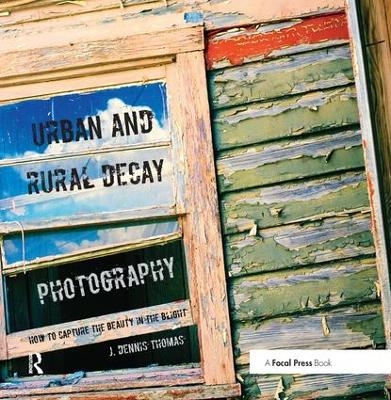
Urban and Rural Decay Photography
Routledge (Verlag)
978-1-138-45803-1 (ISBN)
If you are a photographer who sees the beauty in abandoned buildings, crumbling facades, and preserving a fading history, and who also has a love of urban exploration, you have stumbled on a must-have for your photographic library. Urban and Rural Decay Photography offers expert tips and techniques for capturing breathtaking photographs of your favorite decay scenes, whether in urban or rural settings. Author J. Dennis Thomas guides you through the history of decay photography, shows you what equipment you will need, and discusses digital, film and HDR capture and composition. The book addresses which artistic considerations work best for the kinds of shots that capture a moment and convey a story. He also provides you with important safety advice and matters of the law when entering and working with decaying structures.
Chock full of inspiring images that will ignite your creativity and your passion for decay photography, Urban and Rural Decay Photography is just the book you need to get you out and discovering your newest urban or rural exploration adventure.
J. Dennis Thomas is a photographer and author based in Austin, TX. He has been photographing a wide assortment of subjects for over two decades and has published over two dozen books and dozens of articles. His photographs have appeared in many?prestigious magazines, including Rolling Stone, SPIN, and Country Weekly, and have been displayed in galleries across the country. His fascination with decay photography?started in his early career and has continued to develop to this very day.
Introduction. Chapter 1: About Decay Photography. Key Photographers. Urban Decay. Rural Decay. Safety Issues. Legal Issues. Photographer’s Rights. Chapter 2: Equipment. Cameras. SLR’s and DSLR’s. Rangefinders. TLR. Toy Cameras. Smartphones. Compact Cameras. Point and Shoots. Mirrorless cameras. Lenses. Wide-angle. Mid-Range, Standard, or Normal. Telephoto. IS, VR, OIS, and more. Tripods. Chapter 3: Composition and Technique. Quality of Light. Rule of Thirds. Balance and Symmetry. Leading Lines and Patterns. Textures. Color. Isolating the Subject. Chapter 4: Shooting Digital. Sensors. Analog to Digital. Resolution. Dynamic Range. Exposure. Aperture. Shutter Speed. ISO Sensitivity. Using Histograms. Shooting RAW. White Balance. Noise and Noise Reduction. High ISO Noise. Long Exposure Noise. Noise Reduction. Chapter 5: Shooting with Film. Film Types. Black & White Negative. Color Negative. Transparency or Color Positive. Instant (Polaroid). Film Processing at Home. Supplies. Loading Film. Chemistry and Processing. Chapter 6: Shooting in Low Light. Settings. ISO Sensitivity. Shutter Speed. Aperture. Digital. Shoot RAW. Set your white balance. Exposure. Noise Reduction. Film. Reciprocity Failure. Chapter 7: Digital Post Processing. Finding the Keepers. Metadata. Tonal Adjustment and Color Correction. Black and White Conversions. Color Conversions. TtV: Melding Film and Digital. Chapter 8: High Dynamic Range. Bracketing. Tone Mapping. Exposure Blending. Software. Chapter 9: Decay Portraiture. Gear and Settings. Lighting Tips. Soft Light and Hard Light. High Key and Low Key. Direction. Available Light. External Light. Index.
| Erscheinungsdatum | 07.10.2017 |
|---|---|
| Verlagsort | London |
| Sprache | englisch |
| Maße | 229 x 229 mm |
| Gewicht | 453 g |
| Themenwelt | Kunst / Musik / Theater ► Fotokunst |
| Sachbuch/Ratgeber ► Freizeit / Hobby ► Fotografieren / Filmen | |
| Informatik ► Grafik / Design ► Digitale Bildverarbeitung | |
| ISBN-10 | 1-138-45803-1 / 1138458031 |
| ISBN-13 | 978-1-138-45803-1 / 9781138458031 |
| Zustand | Neuware |
| Haben Sie eine Frage zum Produkt? |
aus dem Bereich


